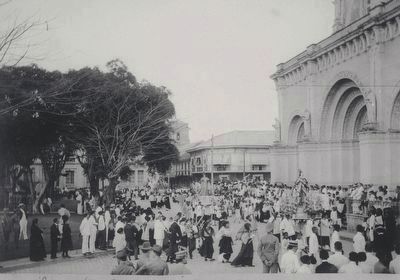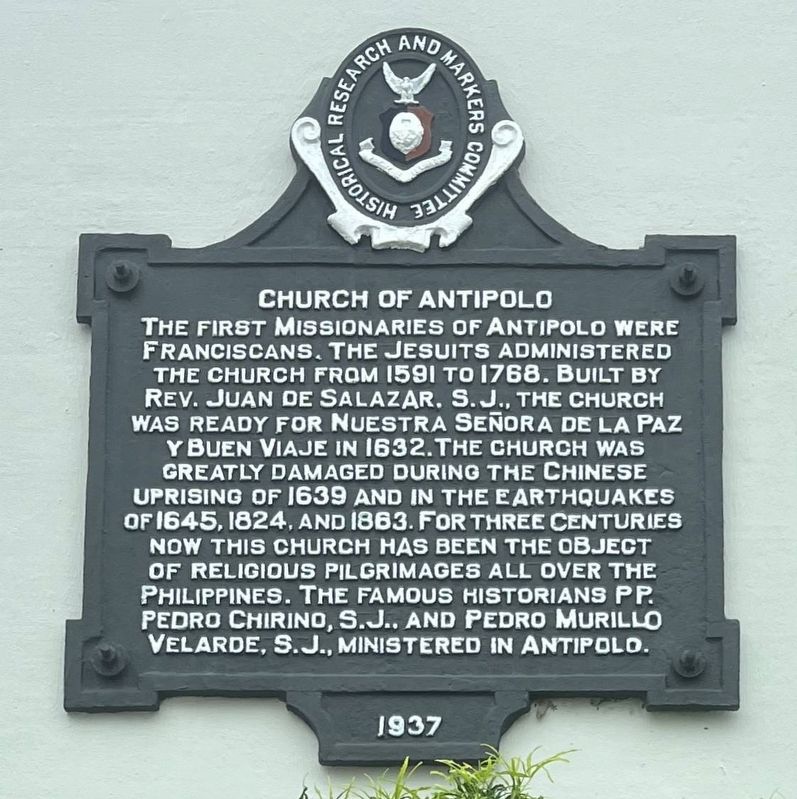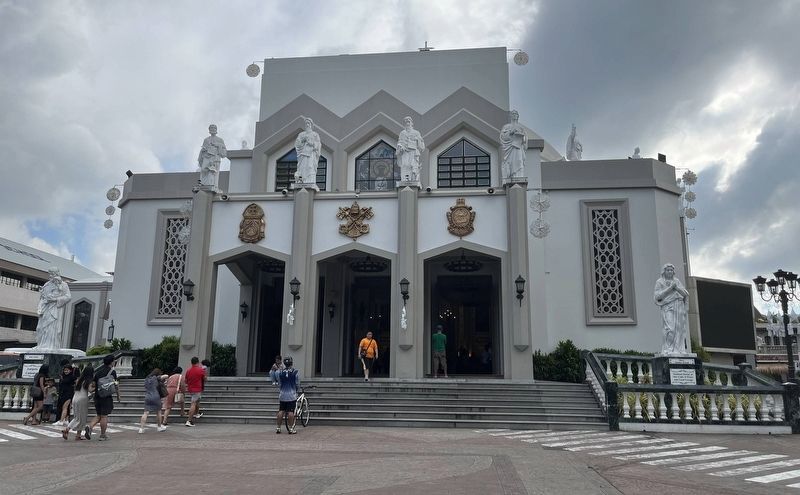Antipolo in Rizal, Calabarzon, Philippines — Southeast Asia
Church of Antipolo
Erected 1937 by Historical Research and Markers Committee.
Topics. This historical marker is listed in this topic list: Churches & Religion.
Location. 14° 35.267′ N, 121° 10.584′ E. Marker is in Antipolo, Calabarzon, in Rizal. Marker can be reached from P. Oliveros Street. On the wall outside the church, to the left of the entrance. Touch for map. Marker is in this post office area: Antipolo, Calabarzon 1870, Philippines. Touch for directions.
Other nearby markers. At least 8 other markers are within 21 kilometers of this marker, measured as the crow flies. Nuestra Señora de la Paz y Buen Viaje (a few steps from this marker); Juan M. Sumulong (about 90 meters away, measured in a direct line); Campana de Sto. Cristo del Tosoro (approx. 5.1 kilometers away); Campana de Santiago Apostol (approx. 5.1 kilometers away); Manila American Cemetery and Memorial (approx. 14.6 kilometers away in Metro Manila); Grand Lodge of Free and Accepted Masons of the Philippines (approx. 20.1 kilometers away in Metro Manila); Associacion Feminista Filipina (approx. 20.2 kilometers away in Metro Manila); University of Santo Tomas (approx. 20.2 kilometers away in Metro Manila). Touch for a list and map of all markers in Antipolo.
Also see . . . Antipolo Cathedral (Wikipedia).
Excerpt: The church was completed in 1632, but suffered severe damage in 1639 when the Sangley (Chinese) set fire to the church in a revolt. It was restored afterwards though it was damaged by the 1645 Luzon earthquake, and other earthquakes in 1824 and 1863. Nevertheless, the church became a popular pilgrimage site as many devotees paid reverence to Our Lady of Peace and Good Voyage,[5] including Philippine national hero and polymath José Rizal, who visited the shrine as a boy with his father, Francisco Mercado, on June 6, 1868. The pair went on pilgrimage to fulfill a vow Rizal's mother, Teodora Alonso, had made when she and the boy survived his delivery.(Submitted on February 7, 2024.)
Towards the end of World War II in 1945, the church was destroyed by Allied bombardment meant to liberate the area from the Japanese imperial control.
After the war, a campaign was organized to build a new church, with the fundraising committee headed by former First Lady Aurora Quezon, and Antipolo parish priest Francisco Avendano. Architect José L. de Ocampo was commissioned to design the new shrine. Construction began in 1948 and was completed in 1954.

Unnamed American expatriate in Iloilo, courtesy of University of Wisconsin - Madison Library, 1907
3. Church procession in Antipolo
As noted in Wikipedia, the church “…enshrines a venerated Black Madonna image of the Blessed Virgin Mary under the title of Our Lady of Peace and Good Voyage (Spanish: Nuestra Señora de la Paz y Buen Viaje), and serves as the seat of the Bishop of Antipolo. The shrine attracts millions of pilgrims annually, especially during the pilgrimage season from May to July each year.”
As for the difference in appearance between this photograph and its current appearance? The church was destroyed at the end of WWII and then rebuilt starting in 1948.
Credits. This page was last revised on February 7, 2024. It was originally submitted on February 7, 2024, by Ray Gurganus of Washington, District of Columbia. This page has been viewed 90 times since then. Photos: 1, 2. submitted on February 7, 2024, by Ray Gurganus of Washington, District of Columbia. 3. submitted on February 7, 2024. • Andrew Ruppenstein was the editor who published this page.

